High Temperature Fatigue Behavior and Failure Mechanism of Ti-45Al-4Nb-1Mo-0.15B Alloy
Abstract
1. Introduction
2. Materials and Tests
2.1. Materials
2.2. Test Procedure
3. Results
3.1. Cyclic Stress–Strain Relationship
3.2. Fatigue Behavior
4. Discussion
5. Conclusions
- (1)
- The Ti-45Al-4Nb-1Mo-0.15B alloy does not exhibit significant cyclic softening or cyclic hardening under strain cyclic loading at 400 °C and 750 °C and exhibits relatively stable cyclic characteristics, and its plasticity increase significantly with temperatures. The relationship between the strain fatigue life and the strain amplitude at different temperatures could be accurately represented by the Manson–Coffin model.
- (2)
- The Ti-45Al-4Nb-1Mo-0.5B alloy exhibits significant ductile fracture characteristics at 750 °C: the dimples on the fracture of the fatigue specimen are regular, trans-granular fractures are dominant in equiaxed grains, and there is an obvious separation between grain boundaries. As the strain amplitude increases, the inter-lamellar fracture decreases, while trans-lamellar fracture gradually becomes dominant in the lamellar colony, and the boundary separation between the lamellar colony and the equiaxed grains is more significant.
- (3)
- The Ti-45Al-4Nb-1Mo-0.5B alloy exhibits more obvious brittle fracture characteristics at 400 °C; the dimple on the fracture of the fatigue specimen becomes sharper and more irregular, trans-granular fractures are dominant in equiaxed grains, and trans-lamellar fractures are dominated in the lamellar colony. As the strain amplitude increases, the trans-granular fracture of the equiaxed grain becomes more obvious, and inter-lamellar fracture of the lamellar colony becomes occasionally visible. In addition, oxidation of the material is less obvious than that at 750 °C.
Author Contributions
Funding
Institutional Review Board Statement
Informed Consent Statement
Data Availability Statement
Acknowledgments
Conflicts of Interest
References
- Hodge, A.M.; Hsiung, L.M.; Nieh, T.G. Creep of nearly lamellar TiAl alloy containing W. Scr. Mater. 2004, 51, 411–415. [Google Scholar] [CrossRef]
- Zhang, S.; Zhang, C.; Du, Z.; Hou, Z.; Lin, P.; Chen, Y. Microstructure and tensile properties of hot fogred high Nb containing TiAl based alloy with initial near lamellar microstructure. Mater. Sci. Eng. A 2015, 642, 16–21. [Google Scholar] [CrossRef]
- Wen, Y.; Sun, J. Generalized planar fault energies and mechanical twinning in gamma TiAl alloys. Scr. Mater. 2013, 68, 759–762. [Google Scholar] [CrossRef]
- Kitashima, T.; Kawamura, T. Prediction of oxidation behavior of near-α titanium alloys. Scr. Mater. 2016, 124, 56–58. [Google Scholar] [CrossRef]
- Dong, C.; Yu, H.; Jiao, Z.; Kong, F.; Chen, Y. Low cycle fatigue, creep and creep-fatigue interaction behavior of a TiAl alloy at high temperatures. Scr. Mater. 2018, 144, 60–63. [Google Scholar] [CrossRef]
- Bartolotta, P.; Barrett, J.; Kelly, T.; Smashey, R. The use of cast Ti-48Al-2Cr-2Nb in jet engines. J. Mater. 1997, 49, 48–50. [Google Scholar] [CrossRef]
- Chen, G.; Peng, Y.B.; Zheng, G.; Qi, Z.; Wang, M.; Yu, H.; Dong, C.; Liu, C. Polysynthetic twinned TiAl single crystals for high-temperature applications. Nat. Mater. 2016, 15, 876–881. [Google Scholar] [CrossRef]
- Bewlay, B.; Nag, S.; Suzuki, A.; Weimer, M.J. TiAl alloys in commercial aircraft engines. Mater. High Temp. 2016, 33, 549–559. [Google Scholar] [CrossRef]
- Recina, V.; Lundstrm, D.; Karlsson, B. Tensile, creep, and low-cycle fatigue behavior of a cast γ-TiAl-based alloy for gas turbine applications. Metall. Mater. Trans. A 2002, 33, 2869–2881. [Google Scholar] [CrossRef]
- Zhang, Q.; Hua, X.; Zhang, Z.; Sun, T.; Wu, J.; Li, Y.; Ren, T. The mean stress and phase angle effect on multiaxial fatigue behavior of a TiAl alloy: Failure analysis and life modeling. Int. J. Mech. Sci. 2021, 193, 106123. [Google Scholar] [CrossRef]
- Werwer, M.; Kabir, R.; Cornec, A.; Schwalbe, K.H. Fracture in lamellar TiAl simulated with the cohesive model. Eng. Fract. Mech. 2007, 74, 2615–2638. [Google Scholar] [CrossRef]
- Li, M.; Xiao, S.; Xiao, L.; Xu, L.; Tian, J.; Chen, Y. Effects of carbon and boron addition on microstructure and mechanical properties of TiAl alloys. J. Alloy. Compd. 2017, 728, 206–221. [Google Scholar] [CrossRef]
- Loris, J.S.; Taiki, N.; Yotaro, O.; Ryosuke, Y.; Hirotoyo, N.; Masao, T. Fatigue crack growth behavior of wrought γ-based TiAl alloy containing β-phase. Intermetallics 2018, 100, 77–87. [Google Scholar]
- Li, Z.; Luo, L.; Su, Y.; Luo, L.; Wang, B.; Wang, L.; Yao, M.; Guo, J.; Fu, H. In-situ investigation of β/α transformation in β-solidifying γ-TiAl alloys at different cooling rates. Mater. Lett. 2021, 285, 129092. [Google Scholar] [CrossRef]
- Zhang, K.; Hu, R.; Lei, T.; Yang, J. Refinement of massive γ phase with enhanced properties in a Ta containing γ-TiAl-based alloys. Scr. Mater. 2019, 172, 113–118. [Google Scholar] [CrossRef]
- Cui, W.; Liu, C.; Bauer, V.; Christ, H.J. Thermomechanical fatigue behaviours of a third generation g-TiAl based alloy. Intermetallics 2007, 15, 675–678. [Google Scholar] [CrossRef]
- Bauer, V.; Christ, H.J. Thermomechanical fatigue behaviours of a third generation γ-TiAl intermetallic alloy. Intermetallics 2009, 17, 370–377. [Google Scholar] [CrossRef]
- Sakaguchi, M.; Niwa, Y.; Gong, W.; Suzuki, K.; Inoue, H. Temperature dependent fatigue crack growth in forged TiAl alloys with nearly-lamellar and triplex microstructure. Mater. Sci. Eng. A 2021, 806, 140802. [Google Scholar] [CrossRef]
- Xu, X.; Ding, H.; Li, W.; Huang, H.; Liang, H.; Kwak, S.; Chen, R.; Guo, J.; Fu, H. The smooth and notched three-point bending fatigue behavior of directionally solidified high-Nb TiAl alloy. Mater. Charact. 2021, 181, 111444. [Google Scholar] [CrossRef]
- Chlupova, A.; Heczko, M.; Obrtlík, K.; Dlouhý, A.; Kruml, T. Effect of heat-treatment on the microstructure and fatigue properties of lamellar γ-TiAl alloyed with Nb, Mo and/or C. Mater. Sci. Eng. A 2020, 786, 139427. [Google Scholar] [CrossRef]
- Chen, Y.; Cao, Y.; Qi, Z.; Chen, G. Increasing high-temperature fatigue resistance of polysynthetic twinned TiAl single crystal by plastic strain delocalization. J. Mater. Sci. Technol. 2021, 93, 53–59. [Google Scholar] [CrossRef]
- Yan, S.; Qi, Z.; Chen, Y.; Cao, Y.; Zhang, J.; Zheng, G.; Chen, F.; Bian, T.; Chen, G. Interlamellar boundaries govern cracking. Acta Mater. 2021, 215, 117091. [Google Scholar] [CrossRef]
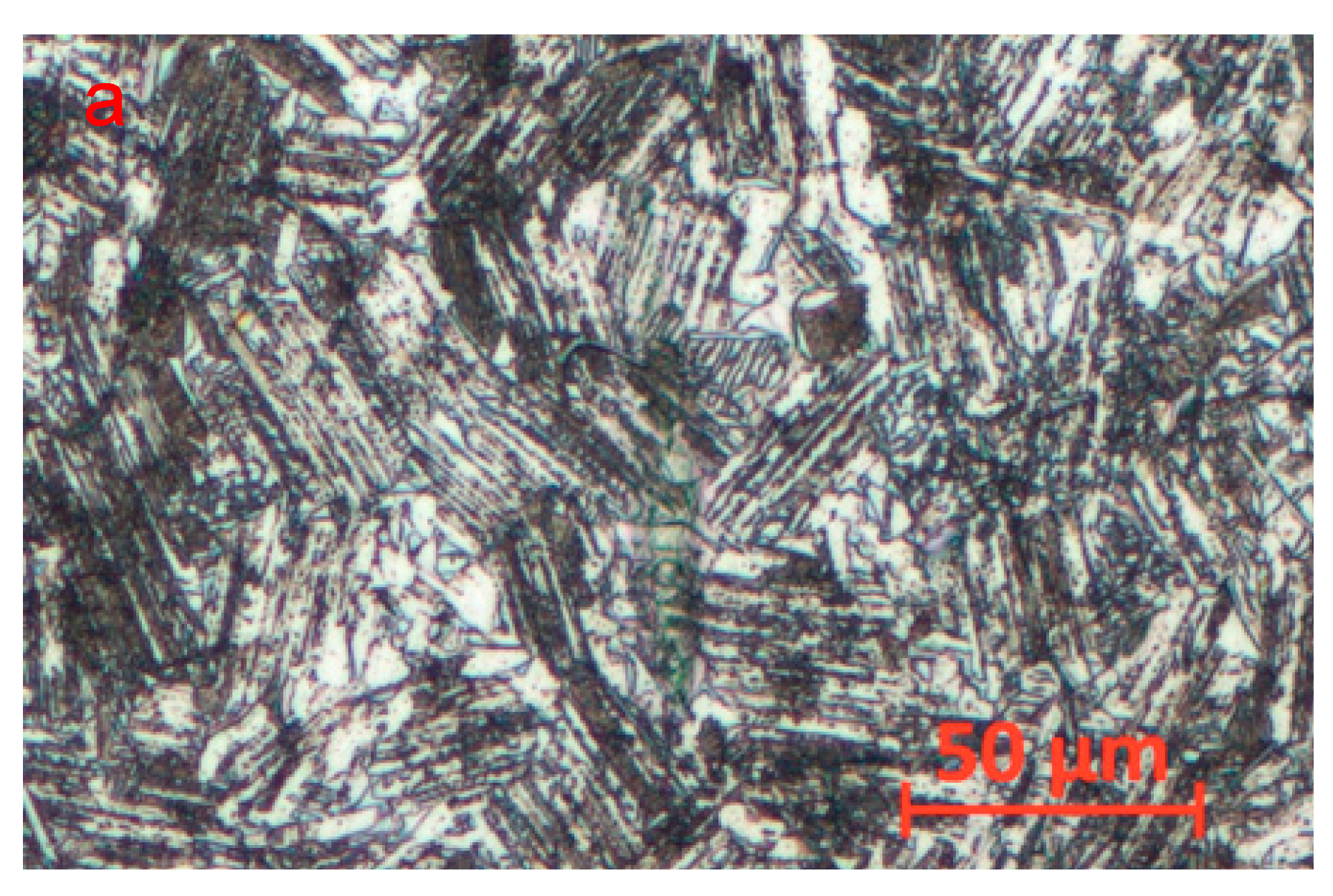
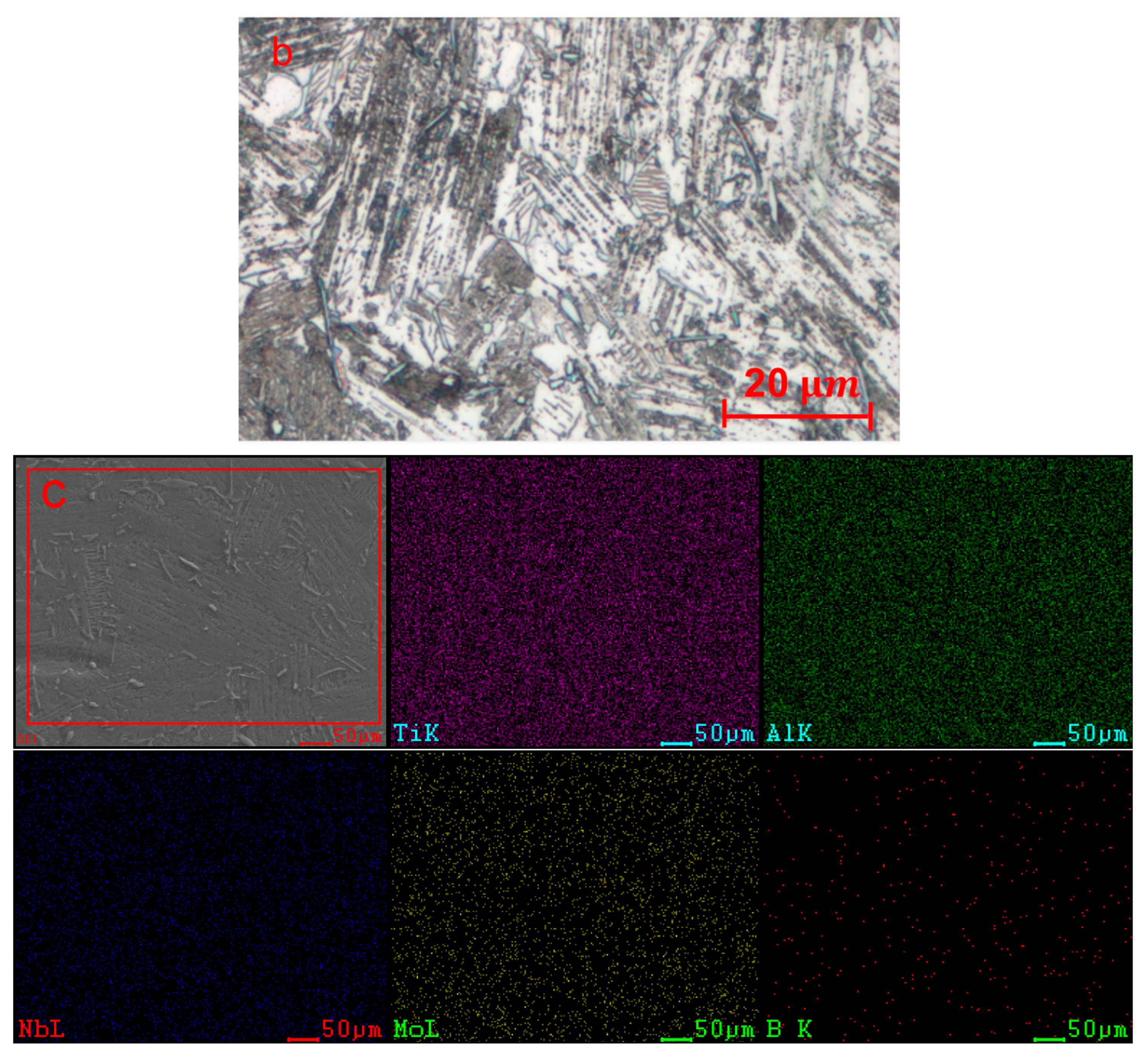
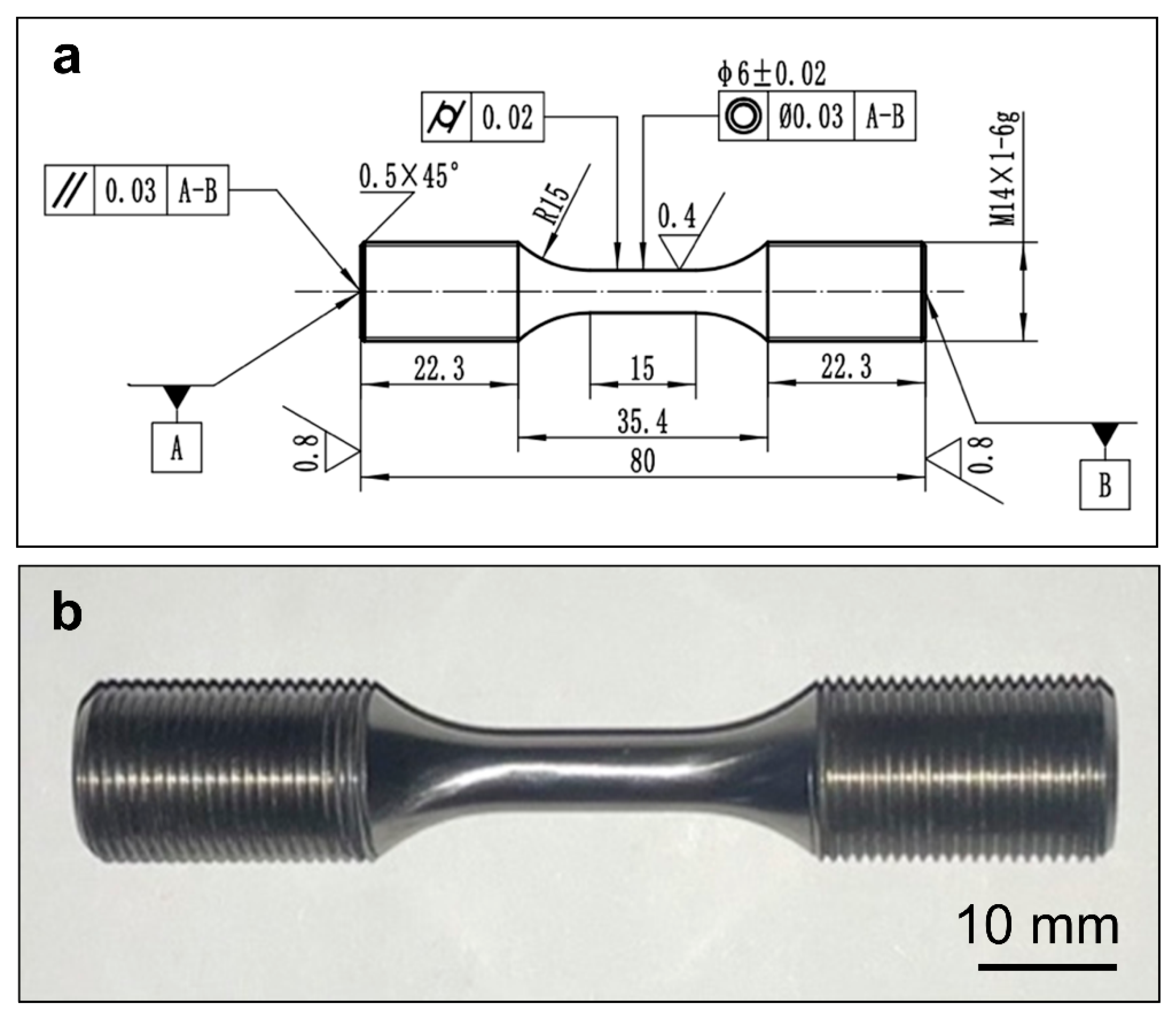
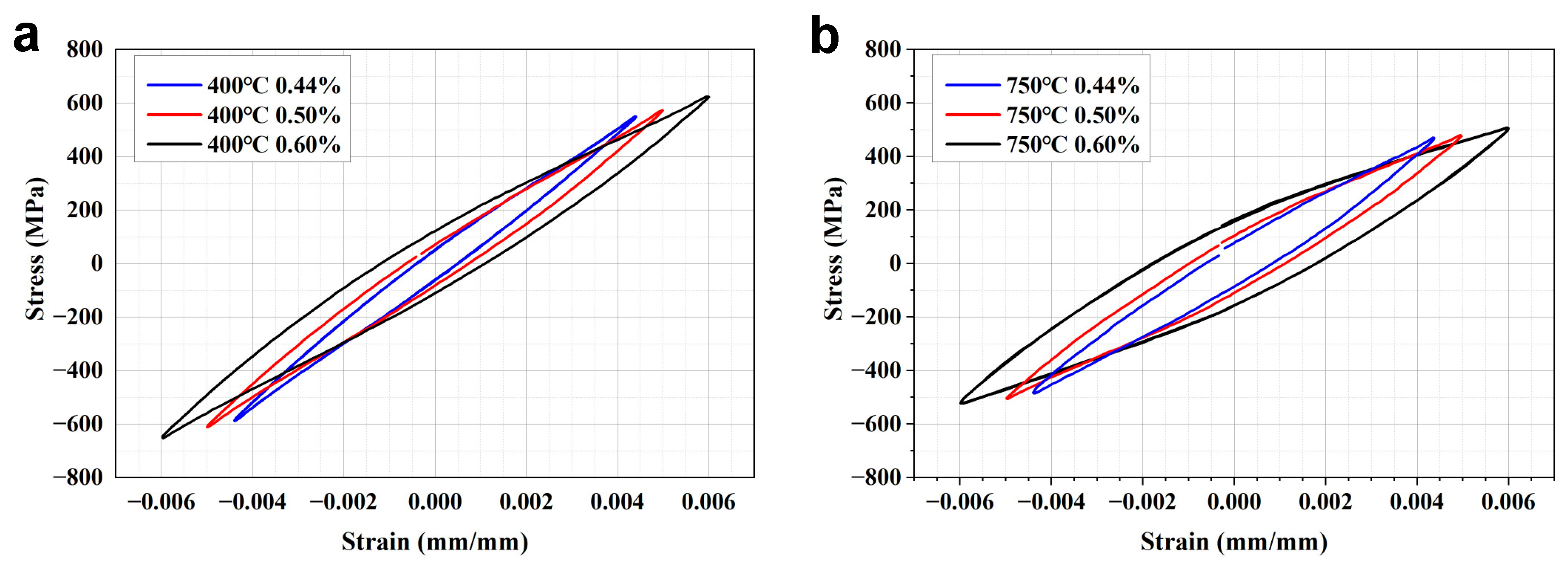
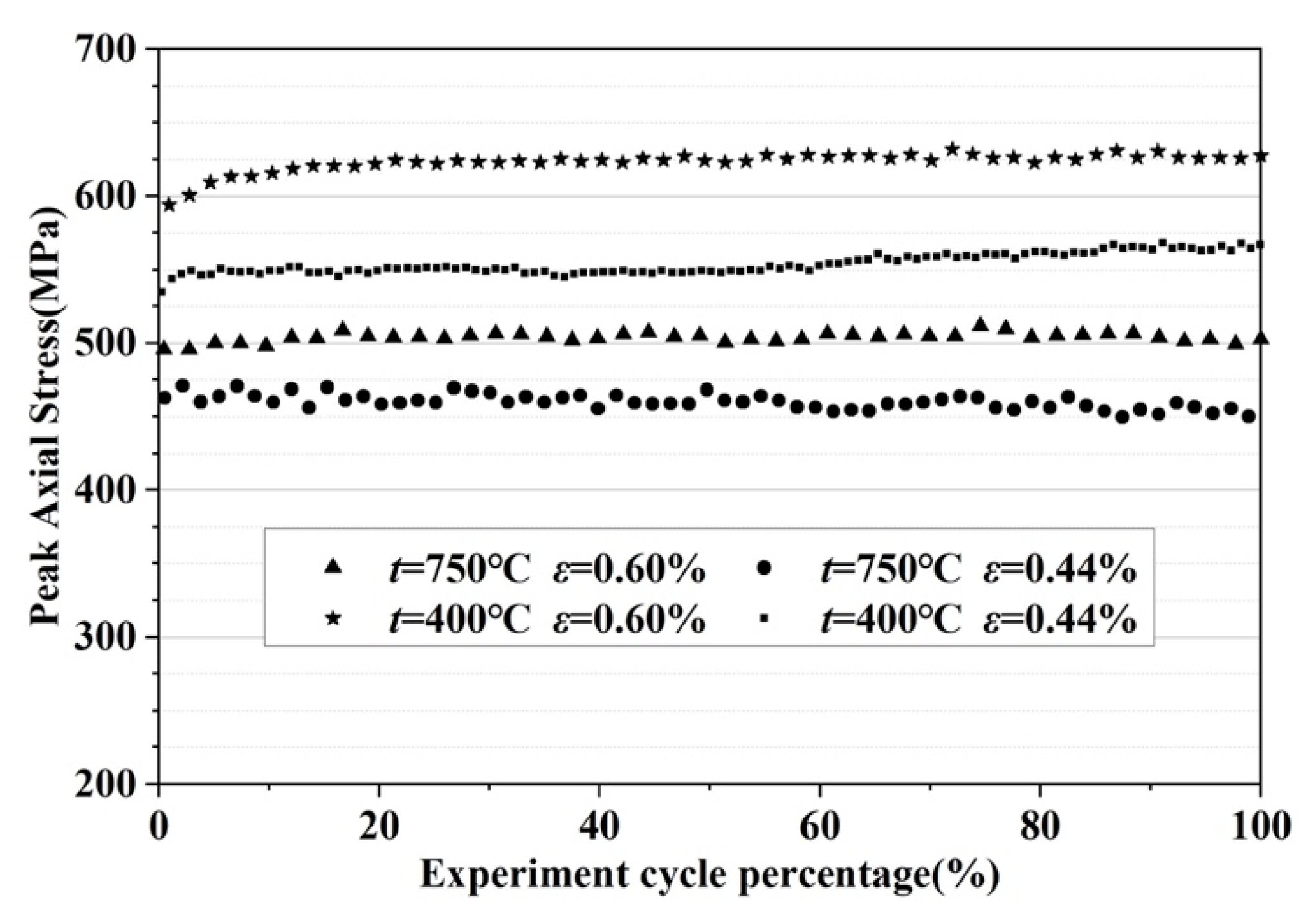

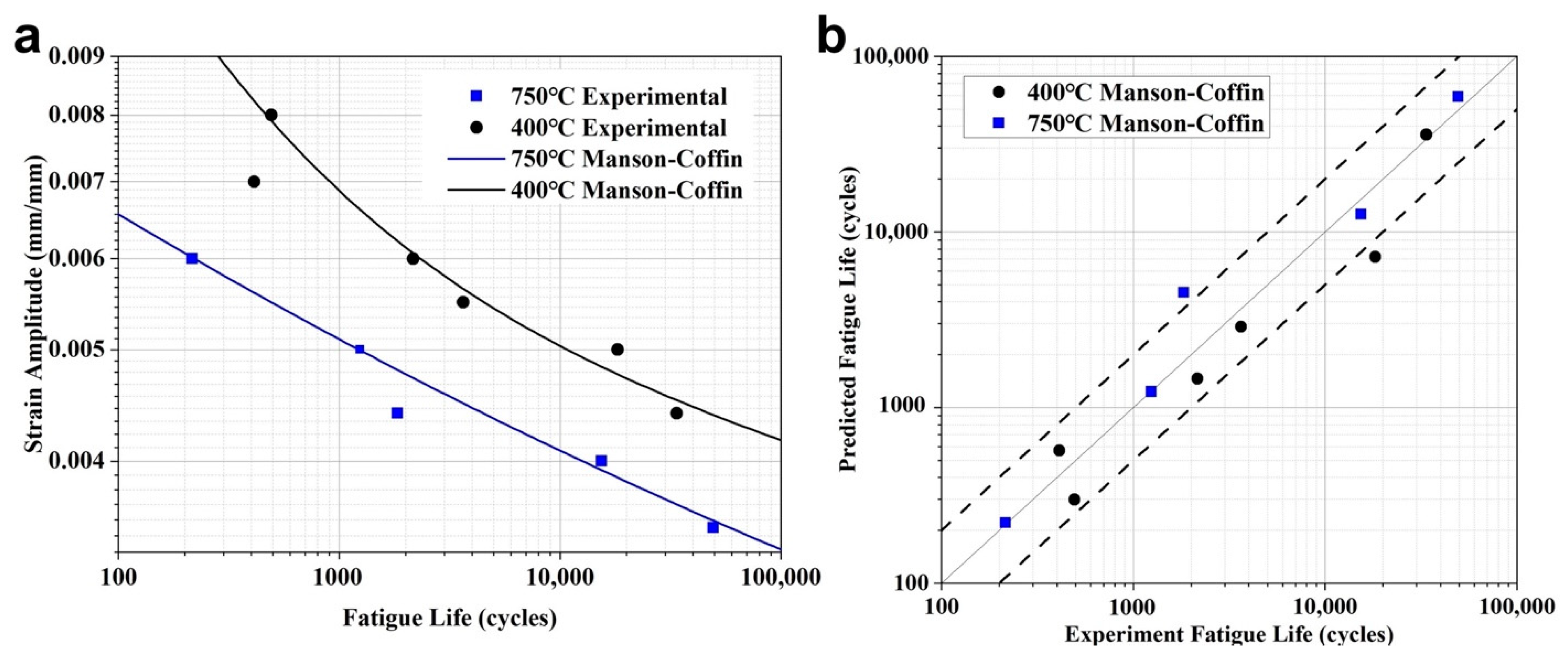
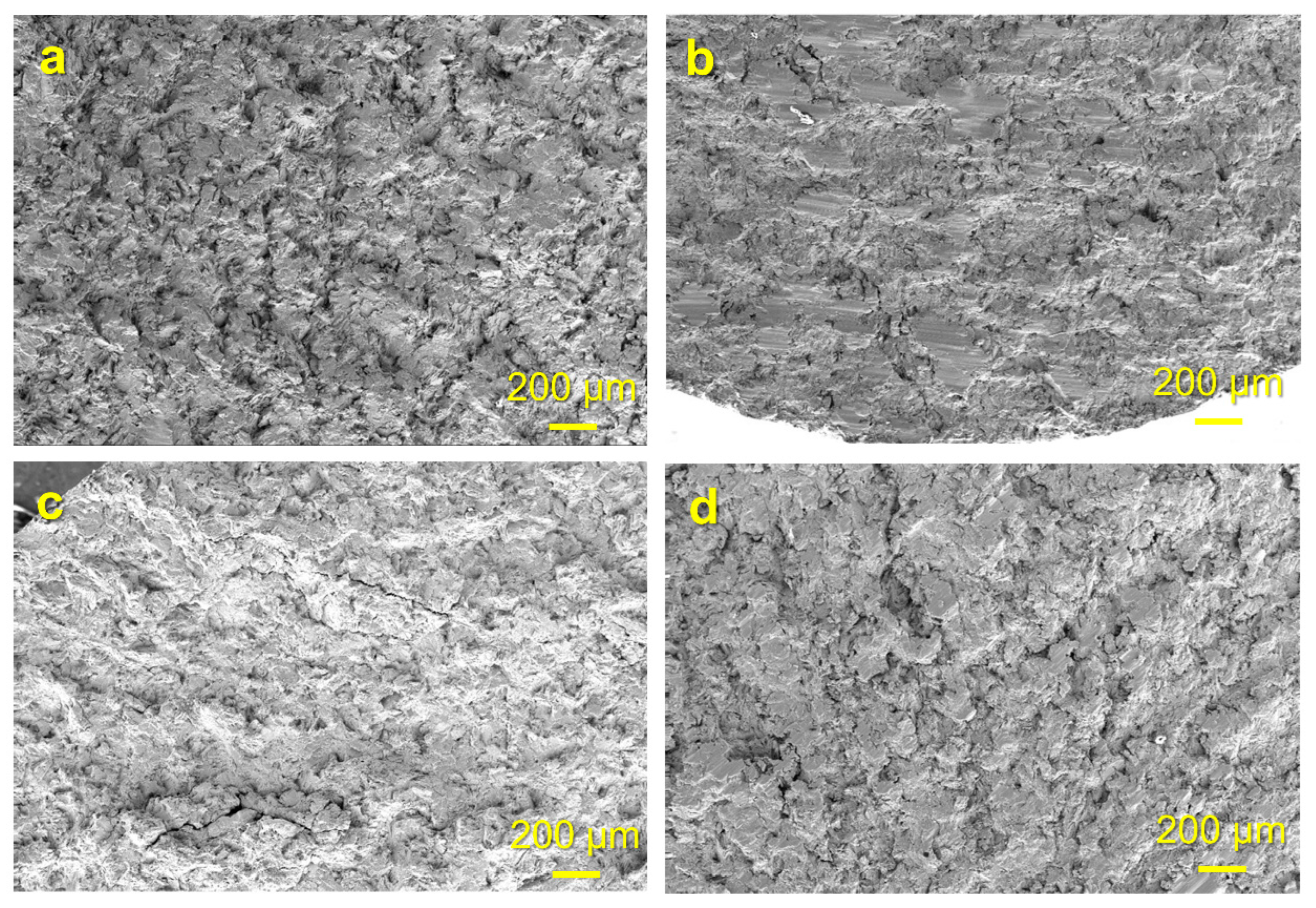
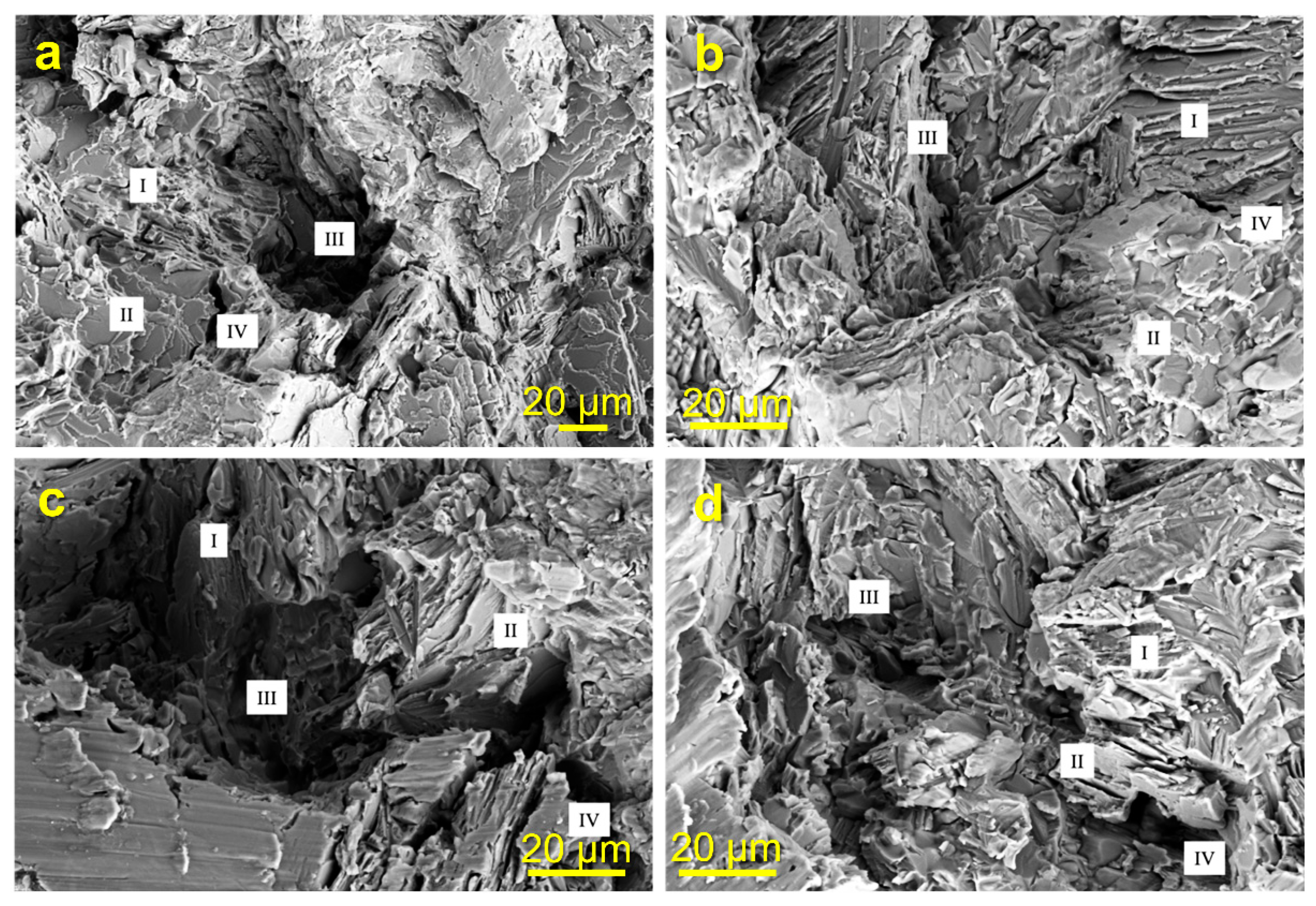
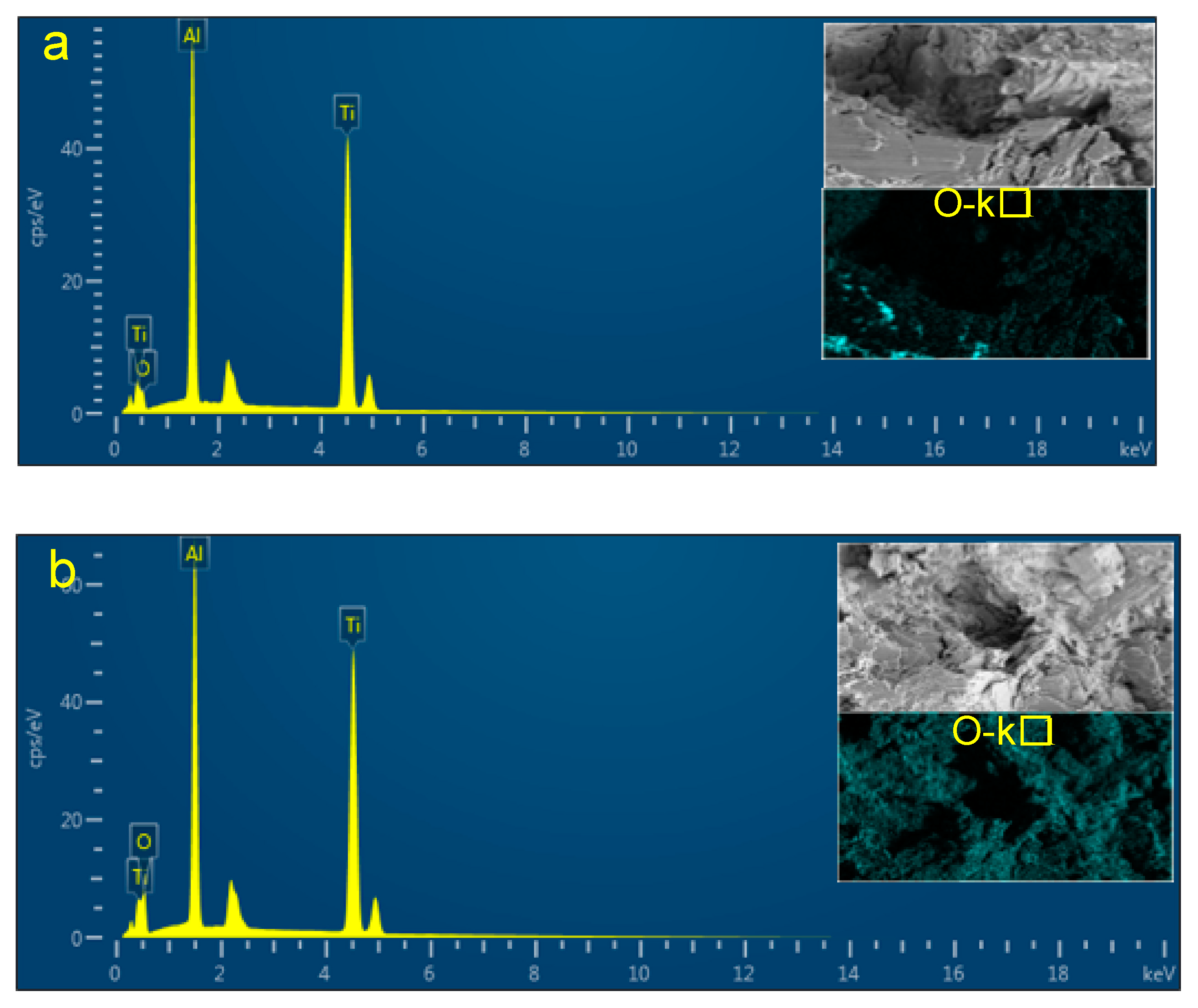
| Temperature (°C) | E (GPa) | K′ (MPa) | n′ | σ0.2 (MPa) |
|---|---|---|---|---|
| 400 | 161 | 1910.3 | 0.1761 | 580 |
| 750 | 134 | 1187.7 | 0.1354 | 495 |
| Temperature (°C) | σf′ | b | εf′ | c |
|---|---|---|---|---|
| 400 | 927.4 | 0.04717 | 0.0274 | −0.3303 |
| 750 | 652.6 | 0.04293 | 0.00894 | −0.2634 |
| 400 °C (Nf = 33,716 Cycles) | 750 °C (Nf = 216 Cycles) | |||
|---|---|---|---|---|
| Element | wt. % | at. % | wt. % | at. % |
| Ti | 66.85 | 49.77 | 61.39 | 41.35 |
| Al | 26.09 | 34.49 | 23.40 | 27.97 |
| O | 7.06 | 15.74 | 15.21 | 30.68 |
Publisher’s Note: MDPI stays neutral with regard to jurisdictional claims in published maps and institutional affiliations. |
© 2022 by the authors. Licensee MDPI, Basel, Switzerland. This article is an open access article distributed under the terms and conditions of the Creative Commons Attribution (CC BY) license (https://creativecommons.org/licenses/by/4.0/).
Share and Cite
Jiang, K.; Li, W.; Chen, J.; Ma, L.; Zeng, W.; Yang, J. High Temperature Fatigue Behavior and Failure Mechanism of Ti-45Al-4Nb-1Mo-0.15B Alloy. Crystals 2022, 12, 1669. https://doi.org/10.3390/cryst12111669
Jiang K, Li W, Chen J, Ma L, Zeng W, Yang J. High Temperature Fatigue Behavior and Failure Mechanism of Ti-45Al-4Nb-1Mo-0.15B Alloy. Crystals. 2022; 12(11):1669. https://doi.org/10.3390/cryst12111669
Chicago/Turabian StyleJiang, Kanghe, Wei Li, Jingwei Chen, Li Ma, Wu Zeng, and Junjie Yang. 2022. "High Temperature Fatigue Behavior and Failure Mechanism of Ti-45Al-4Nb-1Mo-0.15B Alloy" Crystals 12, no. 11: 1669. https://doi.org/10.3390/cryst12111669
APA StyleJiang, K., Li, W., Chen, J., Ma, L., Zeng, W., & Yang, J. (2022). High Temperature Fatigue Behavior and Failure Mechanism of Ti-45Al-4Nb-1Mo-0.15B Alloy. Crystals, 12(11), 1669. https://doi.org/10.3390/cryst12111669







